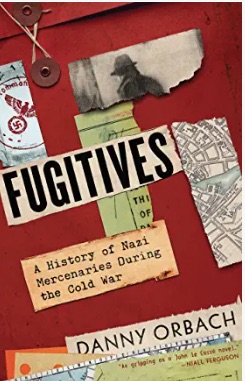
–>
November 6, 2022
The gas vans that used exhaust fumes to kill thousands of Jews during transportation were designed by SS colonel Walter Rauff. He was a friend of Holocaust architect Reinhard Heydrich, and oversaw the killing of 100,000 people. Yet, a few years after World War II, the Israeli secret service hired him as a spy and helped him flee justice to South America. Rauff also worked for West Germany’s intelligence agency, founded under C.I.A. supervision by another Nazi turncoat, lieutenant general Reinhard Gehlen.
‘); googletag.cmd.push(function () { googletag.display(‘div-gpt-ad-1609268089992-0’); }); }
The Allies swore to bring Nazi war criminals to justice, but only a few were caught and tried. In the 1960s, Israel deployed elite operatives to capture or kill Nazi war criminals. Most famously, Mossad teams spirited Adolf Eichmann from Buenos Aires to trial in Jerusalem, and assassinated Herbert Cukurs (the ‘Butcher of Riga’) near Montevideo. But in Israel’s early years, its existence threatened by Syria, Jordan, and Egypt, it was forced to obtain intelligence from Rauff and other Nazis who had contacts in those countries. During the Six-Day war, too, Israel benefited from intelligence provided by ex-Nazis, and it was a ex-Nazi commando, Otto Skorzeny, whom the Mossad hired to infiltrate the Egypt’s missile project, which employed German scientists, technicians, and security staff.
 Fugitives: A History of Nazi Mercenaries During the Cold War, a new book by Danny Orbach, is a trove of astounding stories of how exigency and realpolitik converged with the ruses and wangles of ex-Nazis keen on saving their skins. The book pieces together a disquieting yet compelling picture of how the C.I.A., the K.G.B., and Mossad recruited Nazi mercenaries without any qualms, helping them evade war-crime trials if it served a purpose. It’s based on declassified documents, including details from Mossad’s archives, and interviews with retired intelligence officers.
Fugitives: A History of Nazi Mercenaries During the Cold War, a new book by Danny Orbach, is a trove of astounding stories of how exigency and realpolitik converged with the ruses and wangles of ex-Nazis keen on saving their skins. The book pieces together a disquieting yet compelling picture of how the C.I.A., the K.G.B., and Mossad recruited Nazi mercenaries without any qualms, helping them evade war-crime trials if it served a purpose. It’s based on declassified documents, including details from Mossad’s archives, and interviews with retired intelligence officers.
Orbach, a history professor and former intelligence officer of the Israeli army, says he’s unsentimental by nature and training. He realizes how, in existential wars, both sides would use all means, fair and foul, and could not afford to be picky about their intelligence assets. For Israel, it was all about being scrappy and resourceful against the Arabs. For the West, the post-World War II reality was the Cold War. Anything that worked was welcomed. As a 2005 report, based on declassified C.I.A. documents, put it, “Undoubtedly, the onset of the Cold War gave American intelligence organizations new functions, new priorities, and new foes. Settling scores with Germans or German collaborators seemed less pressing; in some cases, it even appeared counterproductive.”
‘); googletag.cmd.push(function () { googletag.display(‘div-gpt-ad-1609270365559-0’); }); }
The list of Nazis who profited from the new conflict between Western democracy and communism runs long. Some were mass murderers. But most of them were sharp men driven by an instinct for profit and survival. They reinvented themselves to work for their former enemies, playing bluff and bluster, working multiple angles, running with the Soviets and hunting with the Americans, and vice versa. Orbach writes that the Soviets profited most from this: at one point, some double and triple agents almost crippled the West German intelligence system.
The ex-Nazis even established a “chaotic network of influence and information” and indulged in the dangerous fantasy of becoming the “indispensable patrons of Arab revolutionaries and nationalists, funding neo-Nazi movements across Europe, and establishing a base for German ‘national’ resurgence.” They trafficked arms to the Algerian resistance and to governments in Asia, Africa, South Americas, and the Caribbean, including Castro’s Cuba.
Among those who worked for America was Klaus Barbie, the ‘Butcher of Lyon,’ who used to take orders directly from Eichmann and was responsible for the death of 14,000 people. The U.S. Army’s Counterintelligence Corps (CIC) recruited him for its anti-communist efforts in Europe. Thanks to the CIC, Barbie, who had been sentenced to death in absentia by France, spent 33 years as a free man and fugitive from justice.
Friedrich Schwend, former commander of an SS counterfeiting operation, helped Americans find hidden Nazi assets in Austria and Italy. Dr. Wilhelm Hortl, a former spy for the Sicherheitsdienst (SD), the Nazis’ intelligence agency, sold information to the Americans while also working for the Soviets. The Truman administration ‘imported’ German rocket scientist Wernher von Braun and his entire team. The rockets von Braun made for Hitler killed 5,000 people in Allied nations; some 20,000 concentration camp inmates had died assembling them. He was nevertheless the public face of America’s space program and later headed a NASA space center.
Providing more sustained engagement than the egregious examples, however, is the story of how West Germany’s intelligence agency was virtually created by a former Nazi – Reinhard Gehlen, Hitler’s head of intelligence for the Eastern Front. It’s the story with which the book opens.
Gehlen, who had played a crucial role in analyzing the vulnerabilities of the U.S.S.R. for Hitler’s Operation Barbarossa, had microfilmed his team’s notes and cached them in Elendalm, an alpine meadow near the border between Bavaria and Austria. Using this and the services of his team as bargaining chips, he convinced the Americans to hire him. The ‘Gehlen Org’ that he set up with the C.I.A. eventually became West Germany’s Federal Intelligence Service (BND).
‘); googletag.cmd.push(function () { googletag.display(‘div-gpt-ad-1609268078422-0’); }); } if (publir_show_ads) { document.write(“
Much to his chagrin, Gehlen’s American supervisors were also working with his rival Hermann Baun. Gehlen was tasked with analyzing what Baun’s signal eavesdropping operations gathered. But in the end, given Baun’s erratic behavior, it was Gehlen who prevailed as chief. Baun was asked to establish networks in the Middle East.
Gehlen’s team included many dyed-in-the-wool Nazis, antisemites, and those who took part in the murder of Jews. They had served in the Nazi party, the SS, the SD, or the Gestapo. But he managed to protect them by exaggerating the Red Scare, helping Mossad infiltrate agents into the East, and springing Jews out of communist countries. Their war records were whitewashed because they hunted communists, primarily in West Germany, but also in East Germany and nearby countries. The C.I.A. came to believe that their alleged anti-communism would serve well in the ideological struggle between East and West. Their intrigues and derring-do gave factual credence to the gripping twists of Cold War fiction and films.
Between 1939 and 1945, the Nazis had recruited quite a few Arabs, Iranians, and Turks for intelligence gathering in the Middle East. To the Americans, it seemed logical to reactivate these networks for the benefit of the emerging West German state. It would also gain them leverage over Cairo and Damascus. So, a German intelligence network based on former Nazi operatives took shape in the Middle East, with the full knowledge of the Americans, who hoped to build influence in the region.
Driven by exigency, the fledgling state of Israel was forced to dip into intelligence from this network, even engage with Rauff and some of the most egregious criminals of the Nazi regime. Otherwise, the Arab alliance would have swallowed Israel before it was born. Israel also had to maintain arms shipments and financial aid from West Germany and counter East Germany’s recognition of Egypt, Syria, and other Arab states. However, Israel remained committed overall to bringing war criminals to justice, though it occasionally put off Nazi-hunting to deal with its enemies of the present.
Jewish tradition and learning place immense importance on memory: Zachor – You shall remember – the scriptures admonish repeatedly. Mossad assassination teams would sign off the letter they placed on Nazi targets with: Those Who Never Forget. But governments and spies inhabit an amoral, cynical world. Enemies who become useful become friends – till they can be discarded. Both sides know this, and each tries to outmaneuver the other. Even by those standards, however, what Orbach’s research has unearthed is incomprehensible. That some countries could forget the horrors of the Holocaust is a blight on the memories of the millions who perished in it.
<!– if(page_width_onload <= 479) { document.write("
“); googletag.cmd.push(function() { googletag.display(‘div-gpt-ad-1345489840937-4’); }); } –> If you experience technical problems, please write to [email protected]
FOLLOW US ON
<!–
–>
<!– _qoptions={ qacct:”p-9bKF-NgTuSFM6″ }; ![]() –> <!—-> <!– var addthis_share = { email_template: “new_template” } –>
–> <!—-> <!– var addthis_share = { email_template: “new_template” } –>





